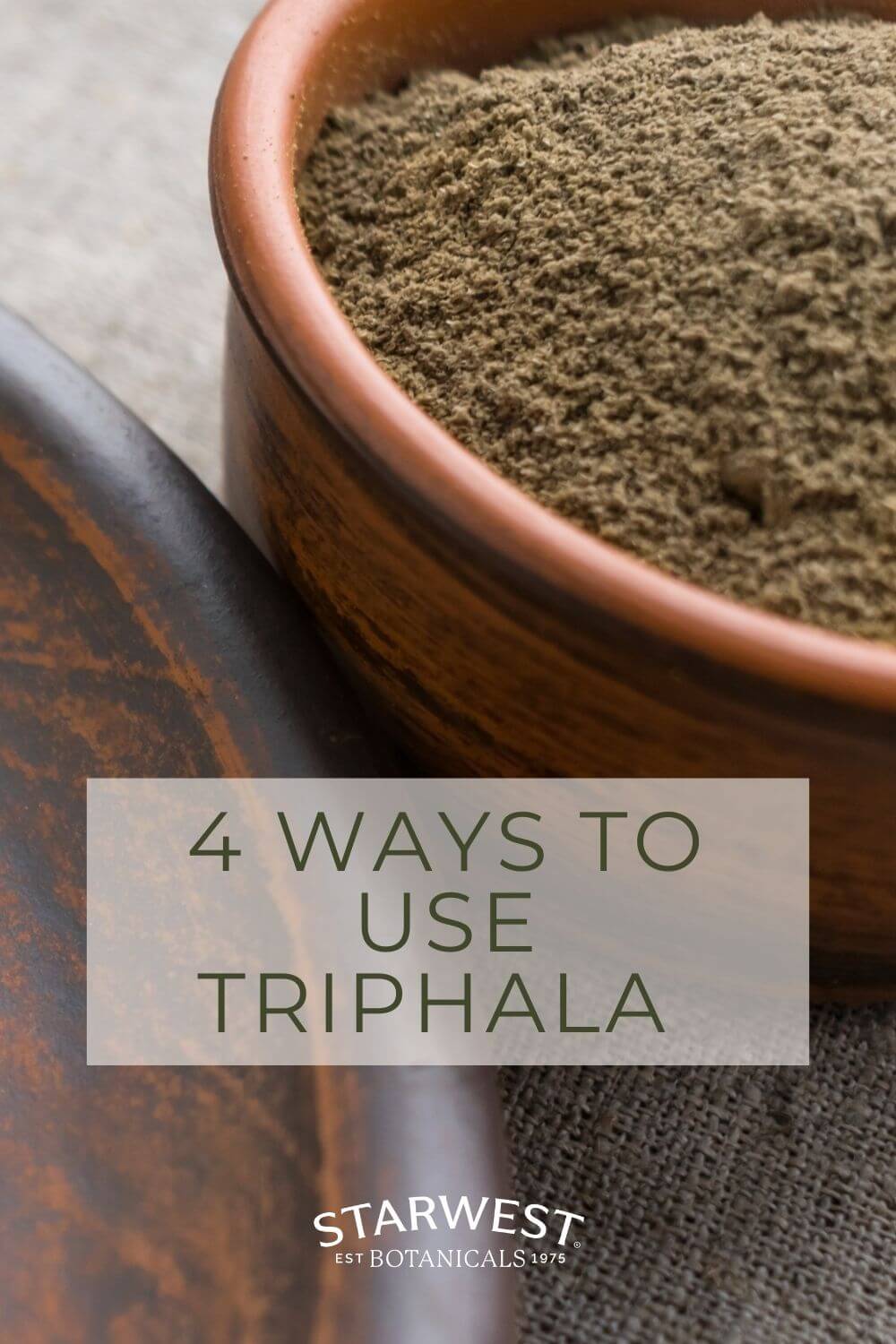4 Ways To Use Triphala in Your Daily Routine | Starwest Botanicals
Posted by Molly McConnell on 09-14-2023

Triphala, a popular Ayurvedic formulation, is most commonly known for its use as a gentle bowel tonic — being helpful in digestion and regularity. It has a synergistic effect to bolster many other systems of the body as well. In addition to the GI tract, Ayurveda recommends triphala to support healthy respiratory, cardiovascular, urinary, reproductive, and nervous systems. Triphala has also been shown to be a powerful antioxidant, which may protect cells from the damaging effects of free radicals.
With all these amazing qualities, it is no wonder that triphala continues to gain attention in the world of natural wellness and remedies. With its cleansing and rejuvenative properties, triphala is often recommended surrounding a digestive reset, but it can also be incorporated into a more regular routine.
Ayurveda invites us to live in alignment with the daily, monthly and seasonal rhythms of nature. Daily routine, also called dinacharya, is one of the pillars of building a more intention and holistic lifestyle. Here are four different ways to weave triphala into your daily routine, depending on the season and what your body needs. Shop organic triphala in bulk here.
Digestive Remedy for Constipation
For daily, gentle colon cleansing, make a triphala tea before bed each night.
How to Make Bedtime Triphala Tea:
- Steep 1 teaspoon of powdered triphala in 1 cup of hot water for 10+ minutes.
- Strain or let the herbs settle to the bottom of the glass and drink the liquid.
Triphala is meant to be taken on an empty stomach, so wait at least 2 hours after dinner before consuming this tea.
Triphala tea at bedtime can be taken any time of year, though it is commonly used in preparation for (and sometimes during) Ayurvedic cleansing. If the body is experiencing excessive dryness (like cracked lips), this variation on triphala may not be your best option. Ask your practitioner for support in determining how to best work with cleansing herbs.
Rejuvenative Tonic
Triphala also makes for a potent rejuvenative tonic, especially when combined with other rejuvenative substances, like honey and ghee. Ghee is similar to a clarified butter and it is revered for its digestibility and full spectrum of nourishment.
How to Make a Rejuvenative Triphala Paste:
- Take ¼ - ½ teaspoon of powdered triphala mixed into a paste with ½ teaspoon of ghee and ½ teaspoon of honey.
- Take on an empty stomach, least 30 minutes before breakfast
Ghee and honey are known as anupan in ayurveda, which means “vehicle” because they are believed to drive the herbs deeper into the tissue. This is yet another example of how Ayurveda utilizes the synergistic effect to get the most healing power out of herbal medicines.
You can learn how to make your own ghee, or find it at your local health food store. If possible, look for one that is grass fed, cultured and organic to receive the maximum benefits. When shopping for honey, go for something that is local to your region, raw and unfiltered.
If you’re already taking triphala tea internally in the evening for constipation, you do not need to take it again for rejuvenation. However, if your bowel movements are feeling steady, you may like to try switching to this morning-time rejuvenative tonic instead.
The remedy is best when incorporated after a cleanse (especially in the winter and summer), or when a person is suffering from deep depletion, exhaustion, or high vata.

Natural Eye Wash
To support discomfort related to eye irritation, a triphala eye wash may be worth a try! For those who are new to natural eye washing, you just might be pleasantly surprised by how calm and clear your eyes feel after. The simple DIY solution is essentially a concentrated triphala tea that has been thoroughly strained. In addition to the triphala, you will need a coffee filter and clean swimming goggles or an eye wash cup.
How to Make and Administer a Triphala Eye Wash:
- Make the solution by soaking ½ teaspoon of triphala in 4 ounces of just-boiled, filtered water. Let sit for 15-20 minutes or until cooled to room temperature. Be very mindful when preparing the solution so as not to contaminate it with bacteria.
- Allow the tea to cool and strain it thoroughly by placing a coffee filter (or a couple layers of cheesecloth) over a small mesh strainer and pouring the liquid through. Make sure there are no particles of triphala remaining.
- To use, fill an eye cup or a clean pair of recently sanitized swimming goggles with the tea and blink your eye(s) open into the liquid for up to 30 seconds. If you have extra liquid, it can be stored in the fridge in a sealed jar and used for up to 3 days.
Toner for the Skin
With its astringent and antioxidant properties, triphala is a cult favorite for natural skin care. To expand your DIY skin care repertoire, try making this two-ingredient toner.
How to make a DIY Facial Toner
- Make a concentrated triphala tea as instructed above.
- Strain out the particles and set aside to use as a facial/body scrub, or dispose.
- Store the liquid in a small jar with a secure lid (or spray bottle) in the fridge for up to a week.
To apply, gently wipe or spray triphala toner onto the skin before moisturizing to tighten and tone the pores. If you’re re-purposing the strained triphala particles as a facial exfoliant, you can simply add a pinch to your cleansing routine.
Author Bio
Molly McConnell is a Certified Ayurvedic Practitioner who is committed to cultivating collective wellness. Guided by curiosity, embodied listening, and the rhythms of nature, Molly’s approach to Ayurveda is intentional and intersectional. As the cofounder ofCultivate Balance, she supports purpose-oriented people to come home to their bodies and restore resilience through nourishment, ritual, and routine. For a more immersive experience,Connect with Molly 1:1 or check outThe Reset for Resilience.
Instagram/Tiktok
Website



